|
Related Articles:
Monterey
Memory | Through
a fissure

Conversations with a tide pool
The
smallest creatures can have the most important voices, for they are the
first to know when the world is changing at a dangerous pace.
By Nancy Bartosek
Photography by Scott Braley

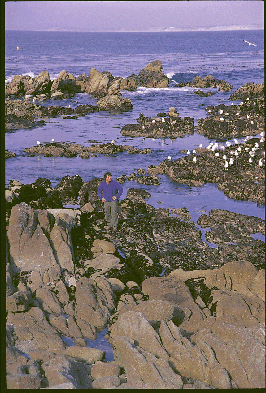 This
is the story of a tide pool. Not a particularly unusual tide pool, but
one much like the others snuggled against the rocky coast of California.
Filled with seaweed and snails and starfish, it is home to waving anemone,
skittish hermit crabs and colonies of mussels. This
is the story of a tide pool. Not a particularly unusual tide pool, but
one much like the others snuggled against the rocky coast of California.
Filled with seaweed and snails and starfish, it is home to waving anemone,
skittish hermit crabs and colonies of mussels.
What makes
this tide pool special involves a little serendipity, a lot of scrutiny
and the sweat and determination of three young marine biology students,
beginning with one named Willis Hewatt.
It is important
because it is about us, too. All of us. For the tiny creatures in this
very small section of ocean have an urgent message for the world -- what
you are doing in a big way is disrupting us in a small but significant
way.
Which means
that our choices are rapidly changing the pattern and flow of nature that
has existed for millennia. And ultimately, this will disrupt and challenge
all of our lives.
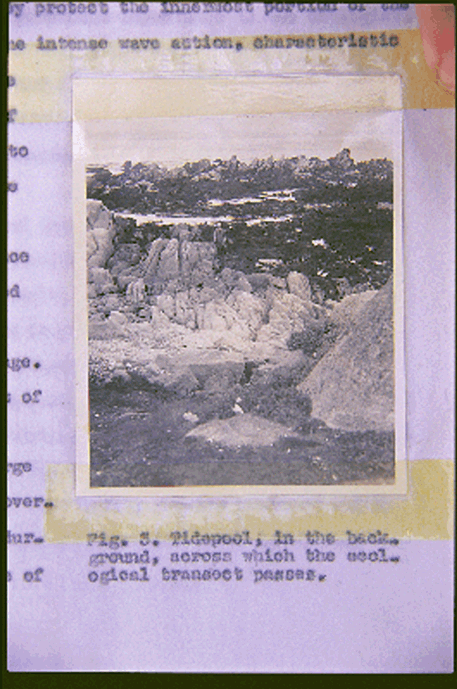 Cabrillo
Point juts like a stubborn chin into the Pacific Ocean at the south end
of Monterey Bay on the central California coast. In the late-1800s a colony
of Chinese immigrants hung shanties over the water and harvested the abundant
treasures of the bay. But their success gave rise to jealousy, and a suspicious
fire destroyed their settlement and drove them off the point in 1906. Cabrillo
Point juts like a stubborn chin into the Pacific Ocean at the south end
of Monterey Bay on the central California coast. In the late-1800s a colony
of Chinese immigrants hung shanties over the water and harvested the abundant
treasures of the bay. But their success gave rise to jealousy, and a suspicious
fire destroyed their settlement and drove them off the point in 1906.
The vacant
land was donated that year to Stanford University, and in 1917 a small
marine studies outpost the university operated in the area was moved to
the point.
Founded
in 1892, Stanford's Hopkins Marine Station was the first marine laboratory
on the American Pacific coast, and the third in the nation. Small gr-oups
of students spent part of their summer on the small rocky point studying
the biology and zoology of the ocean and its environs. Among them was
one John Steinbeck, who attended classes there from 1919 to 1925. He later
chronicled life in the area in Cannery Row and other novels, but though
Steinbeck is an interesting side note, this story begins with a curious
young doctoral student.
Willis Hewatt
landed at Hopkins Marine Station in 1930, newly married and freshly graduated
from TCU with a bachelor's degree and master's degree in biology. No one
still alive knows what prompted Hewatt to head to the coast with wife
Elizabeth the day after their wedding. Nor why he chose Hopkins.
What we do
know is that he spent the next two years slopping about in the rocky waters
at Cabrillo Point, meticulously recording the ebb and flow of life in
the tidal zone. When he completed his study, Elizabeth carefully typed
his findings in triplicate on crisp vellum paper. Then Hewatt taped in
some photographs and charts and presented a bound copy to a doctoral review
board, which stamped its approval and awarded the young scientist a PhD.
The book
was shelved in the Stanford University library where it sat undisturbed,
and mostly forgotten, for many years.
It was the
week before Easter this spring when Joan Hewatt Swaim '56, her daughter
Susan and grandson Asher headed for Monterey Bay. Anticipation ran high.
Joan had not been to the area since she was a young girl, maybe 3 or 4
years old.
Tucked safely
into a carry-on was a copy of her father's dissertation and an old family
album. She knew the two men she was meeting at Hopkins would be interested.
That same
week Chuck Baxter, professor emeritus at Stanford, entered a secured vault
in the Stanford library and removed another copy of the dissertation from
a locked cabinet. Baxter, one of the founders and creators of the famed
Monterey Bay Aquarium, was one of the few who could take that book from
the library.
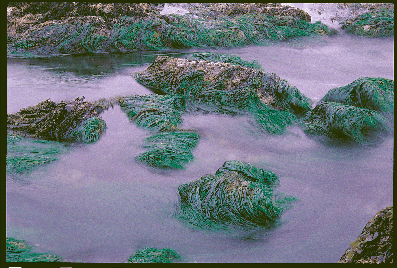 Friday
at 10 a.m., Joan stood peering through the gate at Hopkins. Baxter emerged
from a building, strode purposefully toward her and with gusto stuck his
hand through the slats for a hearty greeting and handshake -- even before
opening the gate to let the visitors in. Friday
at 10 a.m., Joan stood peering through the gate at Hopkins. Baxter emerged
from a building, strode purposefully toward her and with gusto stuck his
hand through the slats for a hearty greeting and handshake -- even before
opening the gate to let the visitors in.
For both,
this was a momentous occasion. Baxter felt a strong connection to Willis
Hewatt, even though the two men had never met. Joan felt instantly that
she had connected with a man "just like daddy."
When Willis
Hewatt began his ecological evaluation, the waters off Hopkins had been
protected from human exploitation for more than 25 years, giving the ambitious
young researcher a relatively undisturbed environment to study.
Ecology was
a fairly new science then, and focusing on the varieties and relationships
between organisms and their environment was considered cutting-edge, and
possibly a bit odd. And while Hewatt knew that no one else had done this
sort of work in the area, he surely didn't know his study would become
an invaluable benchmark 70 years later.
Hewatt focused
on the invertebrates living in a one-yard by 108-yard section, or transect,
that ran from the shore outward. He marked off the area by driving four
brass bolts into granite rocks.
During low
tide the lanky young man would pull on some rubber boots, drag a homemade
square-yard frame down to the rocks and measure out to the spot he was
to study that day. Then squatting in the swirling surf for hours, he would
identify, then tally every living invertebrate inside the frame. With
meticulous hand and discerning eye, he carefully documented seasonal migrations,
food and shelter relationships, water temperature and salinity, the height
and depth of the tides and the amount of time areas were out of the water.
He took compass readings and even drew detailed maps of the rocks.
It took
him two years.
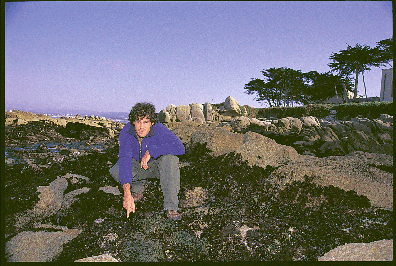 Look
forward 70 years. Rafe Sagarin, a Stanford researcher and protege of Baxter's,
plucks a bright orange starfish from the Hopkins tidal zone and holds
it over his shoulder. Thirteen-month-old Ella, from her backpack perch,
reaches out and gently fingers the cool, firm creature. Like Hewatt did
with Joan and her sister, Sagarin includes his daughter in his work. And
this chilly March morning Sagarin is playing host to yet another photographer
and reporter down in the tide pool by Hewatt's transect. Look
forward 70 years. Rafe Sagarin, a Stanford researcher and protege of Baxter's,
plucks a bright orange starfish from the Hopkins tidal zone and holds
it over his shoulder. Thirteen-month-old Ella, from her backpack perch,
reaches out and gently fingers the cool, firm creature. Like Hewatt did
with Joan and her sister, Sagarin includes his daughter in his work. And
this chilly March morning Sagarin is playing host to yet another photographer
and reporter down in the tide pool by Hewatt's transect.
Sagarin still
calls it Hewatt's transect, even though he could claim it as his own.
From 1991 until 1993, Sagarin and fellow undergraduate student Sarah Gilmore
worked under Baxter's tutelage as they followed Hewatt's careful documentation
and repeated the study step by step.
They were
astonished by what the tide pool told them. So were others. In the intervening
years PBS, the BBC, the Los Angeles Times, the San Francisco
Chronicle, The New York Times and others highlighted the research
in documentaries and news stories. In 1998 the study drew the attention
of President Bill Clinton and Vice President Al Gore, who spent nearly
an hour with Sagarin and others in the tidal zone trying to understand
what those small creatures are revealing about global warming.
Supulorbis
squamigerus is a small tube snail that doesn't look or act much like
you'd think a snail should. This tubular invertebrate attaches itself
to rocks in colonies and sends mucus strands out the open end to collect
food that swishes by in the water.
The odd-looking
creature is abundant 300 miles south near Los Angeles, but when Hewatt
was counting life forms near Monterey, not one was recorded.
Today, this
species is so prolific at Hopkins that you can hardly walk in parts of
the tidal zone without stepping on a cluster.
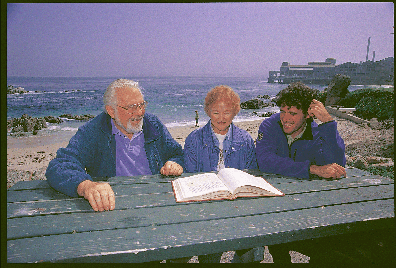 Baxter
began noting such migrations in the 1980s. Discussions with fellow Hopkins
researchers brought Hewatt's study to the forefront, and for nearly a
decade, Baxter tried in vain to interest students in replicating the study.
During his final year of teaching, Gilmore and Sagarin, who Baxter touts
as two of the brightest students to pass through his classroom, took the
bait. Baxter
began noting such migrations in the 1980s. Discussions with fellow Hopkins
researchers brought Hewatt's study to the forefront, and for nearly a
decade, Baxter tried in vain to interest students in replicating the study.
During his final year of teaching, Gilmore and Sagarin, who Baxter touts
as two of the brightest students to pass through his classroom, took the
bait.
In 1995,
Science magazine published the findings: More than 58,000 individuals
from 105 invertebrate groups had been identified. Of the 45 species chosen
for further analysis, 32 exhibited statistically significant changes in
abundance, which indicated widespread shifts in population.
After eliminating
other possible reasons for the change, the report concluded that the shift
was due to the more than two-degree average increase in air and water
temperature between 1930 and 1990. In short, record-breaking climate change
had significantly impacted life in the tidal zones.
A poster
in Sagarin's office proclaims: Global Warming: Early warning signs. Dotted
with nearly 100 points of evidence, including the Monterey Bay study,
the map is colorful but ominous -- malarial outbreaks in Kenya, wildfires
in Russia and Indonesia, ice shelf collapse in Antarctica, devastating
flooding, snowstorms and heat waves in North America.
"People might
not care if a starfish shifts its range, but people certainly care if
a mosquito that carries encephalitis or malaria is shifting its range,"
Sagarin points out. "Especially if it's shifting its range to higher altitudes
and ranges where, for years, cities in Africa, South America and Mexico
have existed in part because they haven't had infestations of mosquitoes."
 Scientists
began to notice significant changes in our ecosystems in the 1970s, though
the marked warming of our atmosphere and planet had been observed much
earlier. By the 1980s, serious study on the effects of this climate change
began in earnest around the world. Scientists
began to notice significant changes in our ecosystems in the 1970s, though
the marked warming of our atmosphere and planet had been observed much
earlier. By the 1980s, serious study on the effects of this climate change
began in earnest around the world.
In 1988,
the Intergovernmental Panel on Climate Change (IPCC) was formed to assess
the growing data from around the globe. Its third report, released in
2001, states unequivocally that:
- The climate
is rapidly warming.
- It
is warming faster than expected.
-
The warming is definitely ascribable to human influence.
Although
local and global temperatures have experienced dramatic changes over the
past 10,000 years, for as long as man has populated Earth there's generally
been a happy balance of gases in our atmosphere that allows our planet
to maintain a pleasant 60-degree Fahrenheit average temperature. Energy
from the sun warms the planet's surface, which returns energy back into
the atmosphere. Greenhouse gases (water vapor, carbon dioxide and others)
trap some of that energy and retain the heat.
But in the
past 120 years, which corresponds to the beginning of the Industrial Age,
the atmospheric concentrations of carbon dioxide have increased nearly
30 percent, methane concentrations have more than doubled, and nitrous
oxide concentrations have risen by about 15 percent, resulting in a rapid
and marked increase in global temperature.
There's no
guesswork about why -- burning fossil fuels to power our cars, trucks, homes
and businesses releases incredible amounts of these greenhouse gases.
Deforestation adds to the dilemma since trees and plants help balance
the amount of carbon dioxide in the air.
Sagarin begins
a fellowship in Washington, D.C., this fall. He's not excited about being
so far from the sea, but he is excited about helping lawmakers try to
change behaviors that will affect the future.
 "The
Florida delegation should be a lot more interested in this than they seem
to be because they are going to be inundated up to Miami, according to
most sea-level rise predictions," he noted. "The
Florida delegation should be a lot more interested in this than they seem
to be because they are going to be inundated up to Miami, according to
most sea-level rise predictions," he noted.
If nothing
changes, the current trajectory indicates that by 2050 carbon dioxide
in the atmosphere will double. According to sea-level rise predictions
based on rise in the past, much of Miami will be under water by then.
"And it's
not just what will be under water," Sagarin added, "but the problems from
the waves of increasingly damaging tropical storms that are expected."
One group
paying attention is the insurance industry. "They are already losing more
money than they've ever seen in terms of storm damage," Sagarin said.
"And they are hiring people who do these long-range predictions of climate
change. They are very, very concerned about this."
We all should
be, he added.
"We need
the support of new laws and changes in laws. (In March) the Senate debated
about whether to encourage automobile manufacturers to get better gas
mileage, and they failed to pass that because you have key legislators
who live in Michigan who just said, 'No, you can't have safe cars or the
cars we want,' which is an absolute lie.
"The biggest
problem we have is translating what we know in science into how policy
gets formulated. We can predict clearly what will happen if nothing changes,
but because we can't prove it will happen, they choose to do nothing."
The intertidal
area at Hopkins is actually more diverse now than when Hewatt investigated
it. So one can't claim complete gloom and doom just because there have
been drastic migrations of the species in the area. And some believe that
the increased carbon dioxide in the atmosphere is helping plants be more
plentiful and healthier.
But when
all the stories from around the world are knit together, the conversations
of the small creatures of the tide pools become significant. They are
like the canary. "No one cares about the canary in the mines," Baxter
said. "But the canary is very important because it tells you what is going
on long before you will realize the danger."

For comments
or questions about this story write to: tcumagazine@tcu.edu
Top
|



